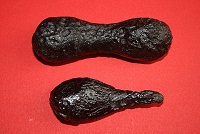
The Natural History Museum's Kieren Howard is on the hunt for evidence of the last major meteorite impact on earth - a hit so large that it scattered ten million tonnes of glass from Thailand to Antarctica 800,000 years ago, yet has left no marks on the earth's surface. Sarah Day reports from the British Science Festival in Birmingham.
Geoscientist online, 15 September 2010
'There should be a massive crater somewhere in South East Asia', says Howard, 'but so far we've not come across any sign of it'.
What we do have are tektites - bizarrely shaped pieces of natural glass, formed when a meteorite impacts throws up material from the earth's surface. Temporarily molten, it then rapidly cools and rains back down in the form of small black or olive-green rocks. Their short lived space flight has led to their shapes being studied for the design of astronaut's re-entry pods.
'There are masses of these tektites strewn across a huge area of Australasia' says Howard. 'That means there should be an impact crater somewhere in South East Asia.
Not only are scientists so far missing a crater, but there is no evidence of the environmental impact such a massive impact must have had. However, flood deposits in Thailand have given Howard some vital clues as to the effects of the meteorite. These contain remains of trees burned in forest fires, mixed in with tektites.
'The surface of the wood is charred, but the centres remain relatively intact', says Howard. 'This is consistent with the idea that forest fires got started, and then were rapidly quenched when the meteorite hit'.
So why hasn't a crater been found? Whilst craters formed by smaller meteorites have been eroded over time, something large enough to produce such a volume of tektites is unlikely to have vanished. Howard suggests it's location, like the Chicxulub crater, is under water and yet to be discovered.
Tektites themselves show up around the world and throughout history, not only in the geological record but in culture.
'It's amazing the effect they've had on cultures across the world', says Howard. 'The names that have been given them are always reflective of how a society views them - the Chinese call them Lei gong mo, which means "black ink pens hurled from the sky by the god of thunder". For all these cultures to have recognised that these objects had something to do with the sky, when they may never have seen them fall, to me is startling'.